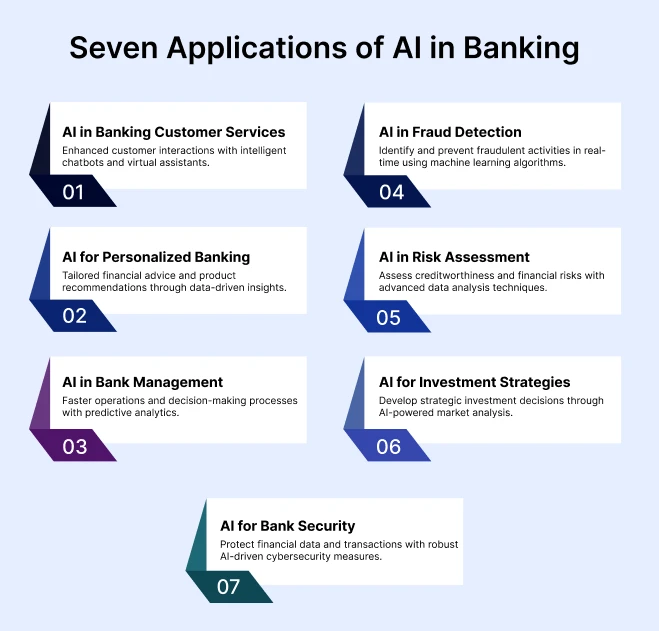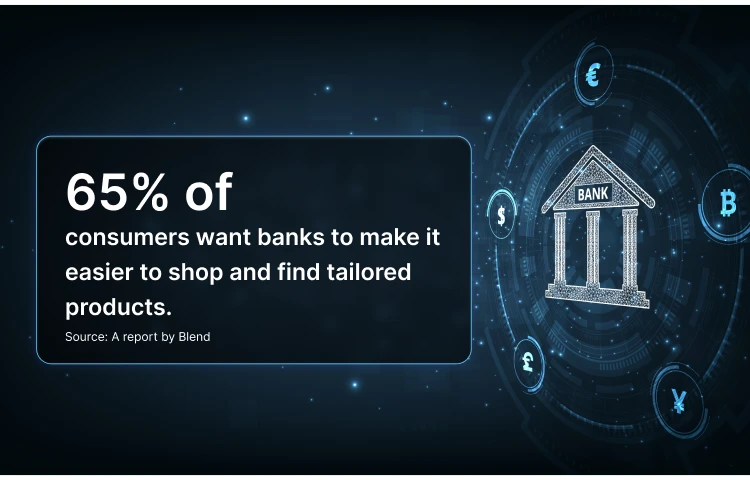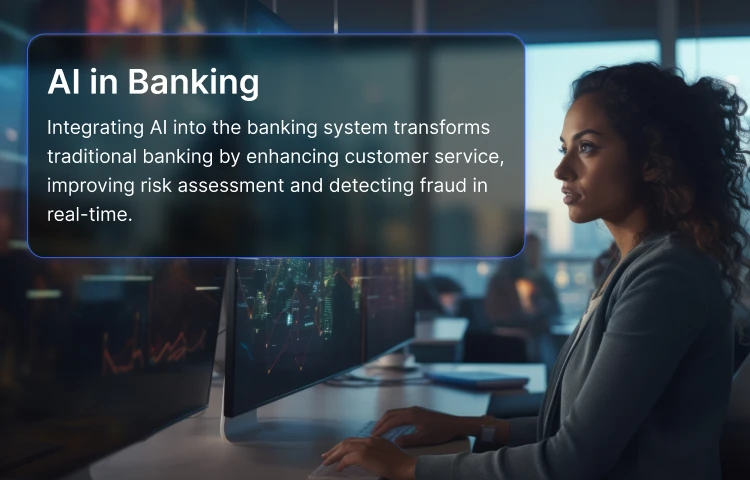AI in Banking: Explore the Transformation With Examples and Use Cases
- June 30, 2024
- 13 mins read
- Listen

Table of Content
Traditional banks are transitioning into digital banks, with artificial intelligence in banking becoming increasingly popular. Approximately 35-40% of banks are already utilizing AI to automate various operations, such as customer service, fraud detection, and documentation.
Although some banks have yet to capitalize on the various advantages of AI, they are actively considering it. They recognize the significant impact of AI on banking, but uncertainties, costs, and other challenges hinder progress. This blog aims to provide detailed and accurate information about AI in banking to resolve queries and confusion among banks considering AI adoption in their systems.
Before that, let’s look at some examples of AI in banking in recent years,
- HSBC (UK): HSBC introduced a new mobile banking platform in 2018. This platform includes fingerprint authentication, mobile payments, and investment tools.
- JPMorgan Chase (US): In 2021, JPMorgan Chase (US) implemented an AI system that analyzes vast amounts of real-time transaction data to identify and prevent fraudulent activity.
- Citibank (US): In 2022, Citibank integrated AI into its mobile app to analyze customer data and offer personalized financial product recommendations. This includes suggesting credit cards with rewards programs tailored to spending habits.
- Allica Bank (Australia): Allica Bank announced partnerships with accounting software providers Sage and Xero in 2023, enabling seamless integration of automatic transaction feeds into their business customers’ accounting systems.
Applications of AI in Banking ( with 25+ use cases)
AI applications in banking operations facilitate a seamless transition towards digital transformation. It strives to improve efficiency, lower risks, and provide a secure, personalized banking experience for a diverse global clientele. Here we’ll explore the uses of AI in banking under 7 most diverse applications,
AI in Customer Services
Customer service is the most prominent among other AI banking solutions. Banking customers often encounter several challenges when seeking customer service. Long wait times for assistance, whether on the phone, through email, or in person at branches, can be frustrating. Inconsistent service quality across different channels or branches also contributes to varying customer experiences. Thus, future-forwarding banks have fully automated their customer services with artificial intelligence.
- Customer Engagement: AI in banking proactively engages customers with appropriate investment choices, personalized products, and timely alerts that fit their financial preferences.
- Chatbots and Virtual Assistants: Implementing AI banking chatbots for instant customer support, handling inquiries, providing account information, and guiding customers through transactions 24/7. Offer personalized financial assistance through virtual assistance.
- Feedback Collection: Feedback is important in understanding customer satisfaction with banking services. Banks can automate feedback collection using the power of artificial intelligence.
- Sentiment Analysis: AI can analyze customer interactions on various channel points. This data helps banks to further improve their services.
- Omni-channel Integration: Omnichannel integration of AI keeps customer experience consistent among different platforms. AI across multiple customer service channels (website, mobile apps, social media) provides seamless experiences.
- Product Recommendation: Every customer has unique preferences for banking products. AI streamlines the communication method in customer services and generates personalized product recommendations.
AI in Bank Management
Banks often have to manage many repetitive and time-consuming administrative tasks. These include updating customer information, handling loan applications, and processing payments. These tasks can create bottlenecks. As a result, overall operations can slow down. Artificial intelligence in banking plays a significant role in automating day-to-day banking tasks.
- Customer Onboarding: AI can quickly verify customer information, such as identification documents, and detect any inconsistencies. For instance, an AI system can scan a customer’s ID and automatically fill in their details. It reduces the time and effort required from both the customer and the bank staff.
- Customer Portfolio Management: Portfolio management with AI helps both customers and banks. AI gathers data from various sources, including customer profiles, historical market data, real-time market data, etc. Then, the algorithm analyzes data to identify patterns and builds personalized portfolios for each customer.
- Automated Credit Checks: Automate credit checks by analyzing a customer’s financial history and credit score. This speeds up the process of determining creditworthiness.
- Automated Loan Approvals: AI can approve or reject a loan application within minutes by analyzing the applicant’s history. It reduces the need for manual review and streamlines loan approvals.
- Regulatory Compliance: With the supervision of AI, banks can automatically flag transactions that might indicate money laundering or fraud. The algorithm swiftly detects unusual transaction patterns that deviate from a customer’s normal behavior. Then, it sends alerts to the compliance team.
- Debt Management: Using AI algorithms, banks can analyze customer repayment patterns to predict potential defaults or late payments. This proactive approach helps banks improve overall debt recovery efforts.
AI in Self-service Banking
In a study by Blend, 65% of consumers expressed a preference for banks to simplify shopping and improve the availability of personalized products. Additionally, 72% considered tailored product offers to be more valuable. This emphasizes the difference between customer expectations for personalized services and the current reality of banking.
One solution to increase customer satisfaction could be integrating self-service banking with AI. AI-powered systems enable customers to perform routine tasks by themselves. So, they no longer need to contact bank agents for minor inconveniences.
- Account Inquiries: Use natural language processing (NLP) to understand and respond to customer queries about account balances, transaction histories, and other account details.
- Bill Payments: AI helps customers set up automatic or one-time bill payments using mobile apps or websites. It securely handles payment instructions, checks details, and schedules payments as customers prefer.
- Fund Transfers: Let your customers do the fund transfers themselves with the help of AI. They can create schedules for regular transfers, such as monthly bill payments or saving deposits. AI monitors account activity and executes transfers according to these set schedules.
- Document Processing: Bank customers often need document processing to use bank products. Leverage Optical Character Recognition (OCR) powered by AI to make document processing easy for your customers. Allow AI to extract data from documents such as IDs and income proofs instead of requiring manual input.
- Predictive Analytics: The rise of AI-powered self-service banking makes predictive analytics more straightforward. AI learns from customer journey patterns and predicts customer’s future financial needs.
AI in Fraud Detection
Fraud detection is another key application of AI in banking. Studies suggest humans make 3-6 errors per hour on average, translating to a significant number daily. Whereas, AI, by design, strives for accuracy and consistency. Errors are typically less common, but not entirely nonexistent.
- Transaction Monitoring: Artificial intelligence can monitor millions of transactions in real-time. It fastens the chance of detecting errors and fixing them according.
- Anomaly Detection: AI learns how customers usually spend money and manage finances. It alerts for a review when there are big changes, such as a sudden increase in online shopping or a large transfer to someone new.
- Document Error: The chance of error in document processing becomes significantly less when the system is powered by AI.
AI in Risk Assessment
AI’s ability to detect anomalies and patterns helps banks proactively mitigate risks. It helps to secure financial stability for the customers and banks. It suggests customers with less fruitful spending categories. And, for banks risk assessment assessment becomes more accurate,
- Spend Category Analysis: Evaluate transactions more effectively with AI. Then, categorize them into relevant spending categories. It helps to uncover hidden cost-saving opportunities and optimize spending strategies.
- Credit Risk Assessment: In the past, banks mainly used credit scores and financial records to evaluate loan applicants. AI can now consider a wider range of details, such as social media habits and money flow patterns. This helps banks assess risk more precisely.
AI for Investment Strategies
Goldman Sachs uses AI algorithms to study market data and forecast trends. This helps them change their investment plans when market conditions shift. It reduces the impact of market changes on their investments.
- Market Analysis: Market analysis is very important before making any investment decisions. However, the manual analysis often takes lengthy procedures. Leverage AI to dictate patterns, trends, and market sentiments.
- Stock Recommendation: AI provides stock recommendations by analyzing historical stock prices, company financials, market trends, and other relevant data.
- Investment Advice: If you do not have the budget to go to a highly-paid investment advisor, no worries. AI can act that for you as well. Generate personalized advice on your investment decisions from simple prompts.
- Stress Testing: Stress testing with AI assesses how strong investment portfolios are when faced with different scenarios, such as market declines or economic challenges.
AI for Bank Security
Bank security is of utmost importance due to the sensitive nature of financial transactions and the personal information involved. Insufficient security leaves customer funds and sensitive financial information open to unauthorized use. Banks may also face cyber attacks like phishing, malware, and ransomware. These attacks can disrupt operations and put data at risk. Here is how AI can be helpful in such scenarios.
- Password and Credential Encryption: AI improves password and credential security by using advanced encryption algorithms to safeguard sensitive data stored in bank systems.
- Identity Theft Protection: Let AI analyze vast amounts of data, including login times, device information, and transaction histories. Establish a baseline of normal behavior for each customer. It prevents identity theft risks among banking customers.
- Adaptive Security Measures: AI detects a new type of cyber attack targeting a specific vulnerability. It can promptly update security protocols and deploy additional protective measures.
AI Implementation in Banking: Cost, Challenges and Tips
The adoption of AI in banking marks a substantial transformation with the multitude of changes it enables. It brings confusion, and challenges and requires the system to go through adapting learning modules. Let’s discuss them one by one,
Are you certain about your choice to transform into an AI-powered bank?- If you are a decision-maker struggling to make up your mind with a convenient decision, this checklist is for you,
- Define the specific challenges or opportunities you aim to address with AI.
- Identify suitable use cases where AI can effectively enhance banking operations.
- Evaluate and analyze potential risks and challenges linked to implementing AI.
- Conduct pilot tests or proof of concept projects to verify the practicality of AI technologies in real banking scenarios.
- Develop a comprehensive roadmap and plan detailing timelines, budget allocations, and roles for deploying AI.
If all this information fits together for a better banking system, Congratulations! you are halfway there. Next, you have to select a vendor who can build your required AI and integrate it into the banking system.
AI Integration Cost in Banking
There’s no fixed answer to how much it costs to implement AI in banking. It relies on variables including solution complexity, implementation scale, vendor reputation, and data infrastructure. For low-complexity solutions like banking chatbots or automated data analysis, the cost typically ranges from $25,000 to $100,000. These systems provide foundational capabilities for improving customer service and operational efficiency.
Mid-complexity solutions, such as AI-powered wealth management tools or certain fraud detection systems, usually require investments ranging from $100,000 to $500,000. These solutions enhance decision-making processes and risk management capabilities within the bank.
For high-complexity solutions like algorithmic trading platforms or advanced customer segmentation models, costs can exceed $500,000. These sophisticated AI applications are designed to optimize investment strategies, personalize customer experiences, and analyze complex data sets at scale.
AI Implementation Challenges
While AI offers significant advantages, it is not without its challenges like any other solution. Below we have the risk factors you should consider before implementing AI.
- Risk of biased decision: AI algorithms can accidentally continue biases found in training data, causing unfair or biased decisions. In 2019, Apple’s credit card algorithm was accused of gender bias as it reportedly offered lower credit limits to women compared to men with similar credit profiles.
Pro-tip: Periodically audit AI algorithms for biases and diversify training data to ensure equitable outcomes.
2. Security vulnerabilities: Handling sensitive financial data with AI is vulnerable to cyber attacks, such as data breaches, hacking attempts, and malware infections. It can compromise customer information and disrupt banking operations. The 2020 Capital One data breach exposed over 100 million customer records because of a vulnerability in their cloud-based AI and machine learning services. Scenarios like these diminish the faith of customers in banking systems.
Pro-tip: Implement robust cybersecurity protocols and continuous monitoring to protect sensitive data from cyber threats.
3. Dependency on AI: Over-reliance on AI systems without human oversight or fail-safe mechanisms can lead to operational disruptions. A major bank faced temporary service disruptions in 2021 due to an outage in its AI-powered transaction monitoring system.
Pro-tip: Establish human oversights to mitigate risks of AI system failures, ensuring uninterrupted service delivery in banking systems.
Tips
Do not forget about the implementation plan. It might take a while for employees and users to adapt to the changes. However, AI is known to make things easier. Here are a few things you can do.
- Continuous monitoring: Regularly monitor AI systems to evaluate performance metrics with your banking systems.
- Collect feedback: Create a feedback loop to collect insights from users on their experiences.
- Training programs: Conduct training for your bank employees and customers to better adapt to the use of AI.
- Regulatory compliance: Stay informed about regulatory standards and ethical guidelines concerning AI applications in banking.
- Look for upgrades: Once the users are comfortable with the existing system, look for upgrades to make it even better. Only then, your bank can stay competitive in the digital banking era.
Concluding fact
Banks that effectively utilize technology to enhance security, efficiency, and customer satisfaction will dominate the future of banking. Without adopting AI, traditional banks risk becoming outdated in a rapidly evolving environment. It’s time to act now. Investing in AI solutions isn’t just about keeping up with competitors; it’s about seizing the opportunity to redefine its footprint in the digital age. Are you ready?
Frequently asked questions
1. What does AI stand for in banking?
Artificial intelligence in banking refers to employing AI-based systems to to automate and enhance various banking operations.
2. Can AI replace bankers?
AI could be used more in banking to enhance overall efficiency. This increased use may decrease the demand for human support. As a result, there might be a shift in job roles and responsibilities. However, AI will not completely replace bankers, as human oversight is necessary to maintain AI operations.
3. How do central banks use AI?
Central banks act as the backbone of a nation’s financial system. Their primary focus is on maintaining monetary policy and financial stability. They employ AI for economic forecasting and financial stability monitoring besides all other tasks AI does for general banks. Adding on, AI in central banks helps in analyzing large volumes of financial data to identify trends and anomalies, which can inform monetary policy decisions.
4. Can AI be biased in banking decisions?
Yes. AI can be biased in banking decisions if there is lack of accuracy in training. Banks must be aware of this and implement measures to mitigate algorithmic bias.
5. What is the future of AI in banking?
AI has the potential to revolutionize banking by making it more efficient, secure, and customer-centric in future. This could include more sophisticated chatbots, personalized financial planning tools, and even AI-powered investment management services.






